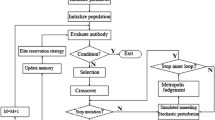Abstract
In today’s economy, manufacturing sectors are challenged by high costs, low revenues. As part of the managerial activities, scheduling plays an important role in optimizing cost, revenue, profit, time, and efficiency by optimization of available resources. The objective of this research is to evaluate the existing artificial immune system (AIS) principles, models, and applications, and to develop an algorithm applicable to job shop scheduling problems. The developed algorithm was based on the theories of the positive selection algorithm and the clonal selection principle. To test the algorithm, ten job shop scheduling problems were evaluated using the new AIS model. To validate the results, the same job scheduling problems were evaluated using a genetic algorithm (GA) model. The results of the two evaluations were compared against each other using the dimensions of optimality and robustness. The testing revealed that the AIS model was slightly less competitive than the GA model in the optimality test but beat the GA in robustness. Another key finding was that the robustness of the model increased as the best solutions produced by the model were closer to the known optimal.






Similar content being viewed by others
References
Adams J, Balas E, Zawack D (1986) The shifting bottleneck procedure for job shop scheduling. Manag Sci 34:391–401
Aickelin U, Burke E, Mohamed Din A (2004) Investigating artificial immune systems for job shop rescheduling in changing environments. In: 6th international conference in adaptive computing in design and manufacture, Bristol, UK
Bersini H, Varela FJ (1990) Hints for adaptive problem solving gleaned from immune networks. Parallel problem solving from nature. pp 343–354
Bersini H, Varela FJ (1991) The immune recruitment mechanism: a selective evolutionary strategy. In: Proceedings of the international conference on genetic algorithm, pp 520–526
Bersini H (1991) Immune network and adaptive control. Proceedings of the first European conference on artificial life. Towards a practice of autonomous systems. MIT Press, Cambridge MA, pp 217–226
Coello CA, Rivas DC, Cruz-Cortés N (2004) Job shop scheduling using the clonal selection principle. ACDM’2004. Springer, Bristol
Dasgupta D (1999) An overview of artificial immune systems and their applications. In: Dasgupta D (ed) Artificial immune systems and their applications. Springer, Berlin, pp 3–21
De Castro LN, Von Zuben FJ (2000) An evolutionary immune network for data clustering. In: Proceedings of the IEEE SBRN’00 (Brazilian symposium on artificial neural networks), pp 84–89
De Castro LN, Von Zuben FJ (2001) aiNet: an artificial immune network for data analysis. In: Abbass HA, Sarker RA, Newton CS (eds) Book chapter in data mining: a heuristic approach, Chap. XII. Idea Group Publishing, USA, pp 231–259
Farmer JD, Packard NH, Perelson AS (1986) The immune system, adaptation and machine learning. Physica 22D:187–204
Fisher H, Thompson GL (1963) Probabilistic learning combinations of local job-shop scheduling rules. In: Muth JF, Thompson GL (eds) Industrial scheduling. Prentice Hall, Englewood Cliffs, NJ, pp 225–251
Forrest S, Perelson AS (1991) Genetic algorithms and the immune system. Proceedings of the parallel problem solving from nature. Springer, Berlin
Forrest S, Javornik B, Smith RE, Perelson AS (1993) Using genetic algorithms to explore pattern recognition in the immune system. Evol Comput 1(3):191–211
Fukuda T, Mori M, Tsukiyama M (1999) Immunity-based management system for a semiconductor production line. In: Dasgupta D (ed) Artificial immune systems and their applications. Springer, Berlin, pp 278–288
Giffler B, Thompson G (1960) Algorithms for solving production scheduling problems. Oper Res VIII:487–503
Hart E (2002) Immunology as a metaphor for computational information processing: fact or fiction? PhD thesis. Artificial Intelligence Applications Institute, Division of Informatics, University of Edinburgh
Hart E, Ross P (1999) An immune system approach to scheduling in changing environments. Genetic and evolutionary computation conference—GECCO 1999, Orlando, Florida, USA. pp 1559–1565
Hart E, Ross P, Nelson J (1998) Producing robust schedules via an artificial immune system. International conference on evolutionary computing, ICEC ‘98, Anchorage, AK. IEEE Press, New York, pp 464–469
Hoffman GW (1986) A neural network model based on the analogy with the immune system. J Theor Biol 122:33–67
Ishida Y (1990) Fully distributed diagnosis by PDP learning algorithm: towards immune network PDP model. In: Proceedings of the international joint conference on neural networks, pp 777–782
Ishida Y (1993) An immune network model and its applications to process diagnosis. Syst Comput Jpn 24(6):646–651
Land AH, Doig AG (1960) An automatic method of solving discrete programming problems. Econometricca 28(3):497–520
Lawrence S (1984) Resource constrained project scheduling: an experimental investigation of heuristic scheduling techniques (Supplement), Graduate School of Industrial Administration. Carnegie-Mellon University, Pittsburgh, PA
Nasaroui O, Gonzalez F, Dasgupta D (2002) The fuzzy artificial immune system: motivations, basic concepts, and application to clustering and web profiling. Published at IEEE international conference on fuzzy systems. In: Proceedings of the IEEE world congress on computational intelligence
Neal MJ (2002) An artificial immune system for continuous analysis of time-varying data. In: Proceedings of ICARIS 2002, Canterbury, UK
Shah N (2004) Using distributed computing to improve the performance of genetic algorithms for job shop scheduling problems. Master’s Thesis, Department of Industrial and Manufacturing Systems Engineering, Ohio University, Athens, OH
Timmis J (2000) Artificial immune systems: a novel data analysis technique inspired by the immune network theory. PhD thesis, Department of Computer Science, University of Wales, Aberystwyth, Ceredigion, Wales
Author information
Authors and Affiliations
Corresponding author
Rights and permissions
About this article
Cite this article
Weckman, G., Bondal, A.A., Rinder, M.M. et al. Applying a hybrid artificial immune systems to the job shop scheduling problem. Neural Comput & Applic 21, 1465–1475 (2012). https://doi.org/10.1007/s00521-012-0852-2
Received:
Accepted:
Published:
Issue Date:
DOI: https://doi.org/10.1007/s00521-012-0852-2




